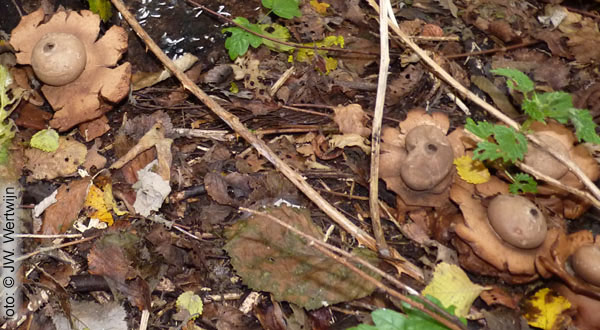
Photo: Spoorzicht, fungi guided tour, October 29. 2011 |
Collared Earthstar
(Geastrum triplex)
NMV Ga 211140
This part of the website primary's concern is the Amsterdam area
|
In Naturepark Spoorzicht life is simple.
All earthstars are Collared Earthstar, even if they have no collar.
|
Earthstars do not like marshy forests. They only exist at the northern part of the park.
That part is the dryest and the highest, and in winter time this size is never drown.
Collared Earthstar are growing in fairy-rings. Since 1997 there were four fairy-rings in Naturepark Spoorzicht.
At places shredded wood was dumped (in 2003) or ditch-slush (in 2007), earthstar fruit-bodies disappeared,
at least until 2012. Perhaps the fairy-rings still alive, but they are not vital.
Collared Earthstar's are not everywhere at the north-side. In the past fruit-bodies only existed at places
where the soil never has been used for sport, and where people could not walk because of scrubs and nettles.
Fairy-rings are always at places with humous and reviving young roots of eml and hazel.
|
|
In 2011 only one fairy-ring was vital enough to make fruit-bodies.
In Oktober and in November 2011 there where about twenty fruit-bodies at both sides of the path near the "light mast ".
It is a strange place. The light mast (of the former baseball-field) is standing on a concrete construction platform
On the concrete is a humousy layer of tree leaves. And in that thin layer on top of the concrete, the mycelium of the fairy-ring is growing.
Also under the concrete, and under the grass-path to the other side. Where people can walk, no fruit-bodies, where they can not,
because of nettles, there were fruit-bodies.
The advantage of an area with only one kind of earthstar is that you become aware of phases and distortions in growth:
|
- de 'tulip-bulb' the first sign of a fruit-doy,
- opening the star-rays,
- the process of lifting the balloon,
- the star-rays releasing from the ground,
- the breaking of the star-rays,
- the process of collar-forming,
- the process collar-wearing,
- the spores puffing in the rain,
- the wearing of the balloon
|
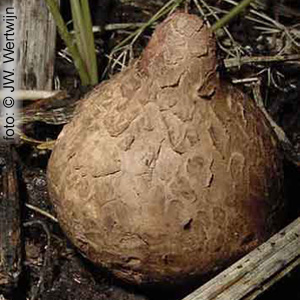
Photo: 'Tulip bulb'
Collared Earthstar |
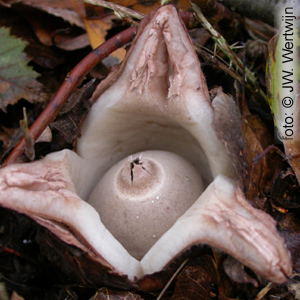
Photo: Collared Earthstar, Spanderswoud, October 21 2006 |
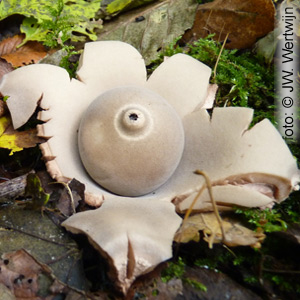
Photo: Collared Earthstar
Spoorzicht, October 26 2011 |
Life is a bit more complex in other areas with two or more Earthstar species, like in Gaasperpark
or in "Het Gooi" (pleistocene area).
|
If you find an earthstar with a collar, probably there are other species with some kind of collar,
like Felty Earthstar (Geastrum saccatum), or Crowned Earthstar(Geastrum coronatum).
If you find an Earthstar without a collar, it still can be a Collared Earthstar, or it can be one of the species without a collor,
like:
.
|
|
Habitat is very important for the species you might expect. In urban areas Sessile, Robust, Elegant en Rosy Earthstar
are dependent on human interference. Sand suppletion and certain planted trees indicate interesting species.
|
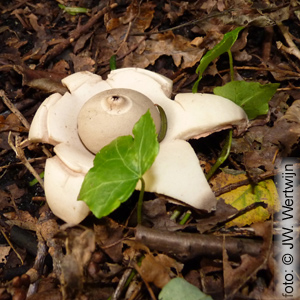
Photo: Collared Earthstar
Gaasperpark, IVN-A'dam guided tour
October 22 2010 |
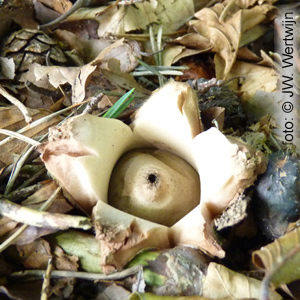
Photo: Collared Earthstar
Kivietsdal, KNNV-Gooi guided tour,
September 5 2010 |
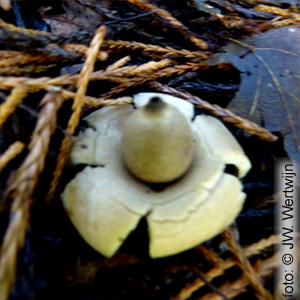
Photo: Collared or Sessile ?
Gaasperpark, IVN-A'dam guided tour
october 13 2011 |
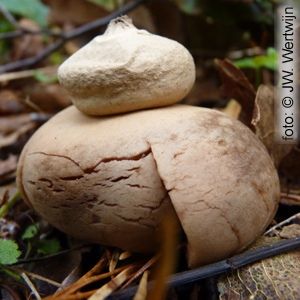
Photo: Collared (saccate=curled)
Spanderswoud,
October 25 2010 |
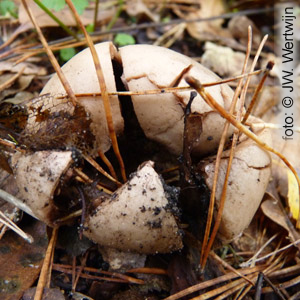
Photo: Collared (saccate, bottom)
Spanderswoud,
October 25 2010 |
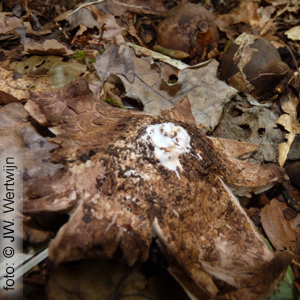
Photo: Collared (bottom scar)
Spanderswoud,
October 25 2010 |
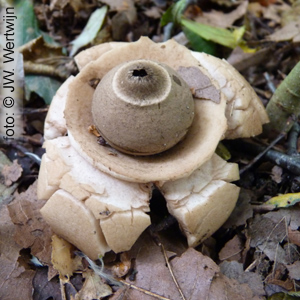
Photo: Collared Earthstar
Gaasperpark, IVN-A'dam excursie,
October 22 2010 |
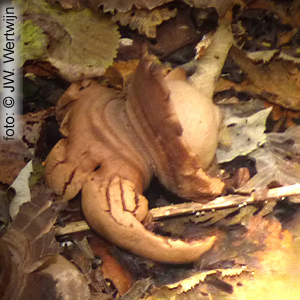
Photo: Collared Growing Pain
Spoorzicht,
October 26 2011 |
.jpg)
Photo: Collared Earthstar
Spoorzicht,
January 9 2005 |
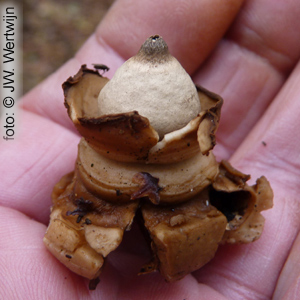
Photo: Collared (top)
Spanderswoud, September, 22 2010 |
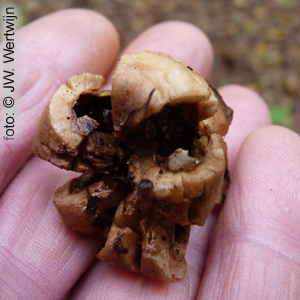
Photo: Collared (bottom)
Spanderswoud, September 22 2010 |
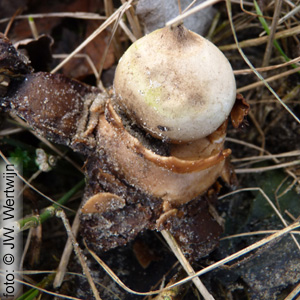
Photo: Felty Earthstar
Meijendel, January 7 2012 |
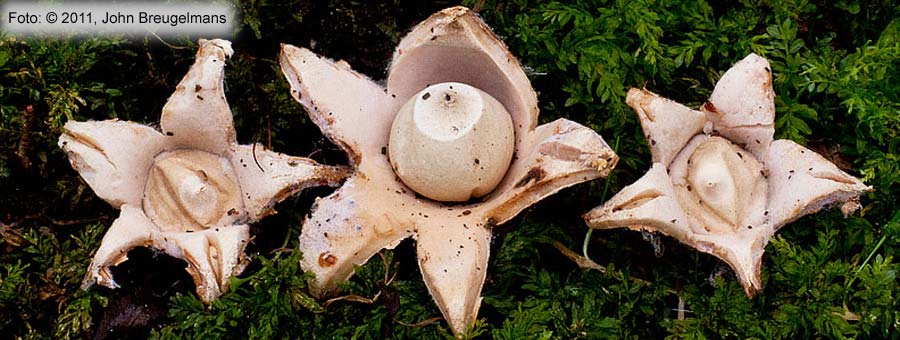
Photo: Collared Earthstar in Rosy format |
The bottom-side of a Collared Earthstar says more than the upper-side.
- The bottom of the star-rays are yellow-brown to reddish brown,
- The bottom of the star-rays are relative baldy,
- The bottom of the star-rays has no encrusted debris, and
- The bottom of the star-rays has a scar in the middle as soon as the fruit-body is opened.
These four field-marks are more important, than having a collar or not.
Someone told me (around 1999) that in case of doubt, a collar-less Collared Earthstar, needs a microscopic check.
That is bloody nonsense. Use your eyes. Search the scar ! |
Habitat:
Saprotrophe. Forms fairy-rings which can exist for decades.
In forests, lanes, parks, gardens, dunes, jumblewood, in yound and old wood.
In deciduous and coniferous woods.
Not in marsh-woods, and not in forest on peatland, except sometimes in the neighbourhood of
shredded wood pathes.
On a dry till relative moisty, fertile soil (often in the neighbourhood of bramberries and/or nettles.
Wood species:
Deciduous (Black Elder, Hawthorn, Common Spindle Tree, Sea Buckthorn, Common Dwarf Willow,
rose, Common Birch, beech, Common Oak, Ash, Maple, Elm, Lime, Buckeye, Black Cherry )
Coniferous (pseudotjuga, picea, pinus)
|
Comparative: (Be aware of scar and felty layers)
- Rosy Earthstar (Geastrum rufescens)
Encrusted debris, no scar, bottom brown, sometimes with a rosy tone.
This earthstar had been found at the southern border of Het Gooi around 1960.
- Sessile Earthstar (Geastrum fimbriatum)
Encrusted debris, no scar, bald white star-rays-bottom.
Sessile Earthstar can be found in Gaasperpark, Fransche kamp, and in the Vuursche.
- Felty Earthstar (Geastrum saccatum)
No encrusted debris, great round scar, felty bottom layer at star-rays bottom.
Felty Earthstar is one of the Northsea dunal coast species. It is not found in the urban Area of Amsterdam,
and it does not grow in the pleistocene area.
|
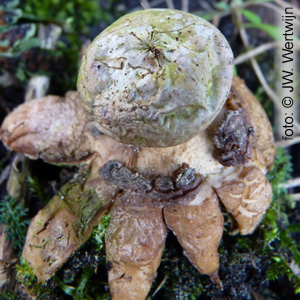
Crowned Earthstar(Geastrum coronatum)
Under certain conditions a collar-like shape is formed |
Comparative: (Be aware of a scar)
- Crowned Earthstar (Geastrum coronatum)
Encrusted debris, no scar, often a little bit smaller, has brown coloring star-rays, and sometimes develops a collar like
shape if the star-rays top-skin is breaking
|
Field-marks:
See: Anatomy of the Genus Geastrum
Field-marks Collared Earthstar:
- Average big to very big size
- Often clear standing collar, sometimes no collar
- Balloon color young: light grey-brown
- Balloon color old: reddish brown till chestnut-brown
- Balloon surface: baldy
- Balloon mouth-zone: fimbriate, often with sharp bordered light court, normally without a ring-furrow
- Stem: no stem, no apophyse
- Star-rays number: 4-8
- Star-rays bottom: baldy(non-felty), (yellow-)brown, often with bursts in the length
- Star-rays: no encrusted debris
- Star-rays: non-hygroscopic
- Star-rays Injuring color changes: no
- Star-rays self-injuring color changes: rosy till reddish brown
- Star-rays bottom: clear scar in the middle
- Star-rays form: convex till lightly saccate
|
Literature:
Chrispijn, R. ed. (1999), Champignons in de Jordaan (De paddenstoelen van Amsterdam), Schuyt en Co, 162-163.
Gerhardt (2006), De grote Paddenstoelen Gids (voor onderweg), Tirion Natuur, 616.
Hansen, L & K. Knudsen (1997), Nordic Macromycetes, Kopenhagen, Vol 3, 345.
Jalink (1995), De aardsterren van Nederland en België, Coolia 38 supplement, 59-60.
Pegler, e.o. (1995), British puffballs, earthstars and stinkhorns, an account of the british gasteroid fungi, Royal Botanic Gardens, kew, 1995, 255 pp.
Vermeulen (1999), Paddestoelen, Schimmels en Slijmzwammen van Vlaanderen, Wielewaal, Turnhout, 541.
www.mycobank.com
|
Top
|